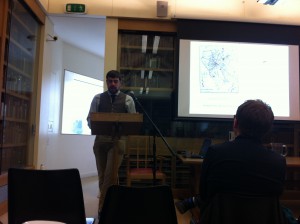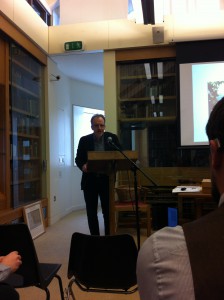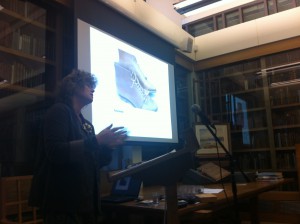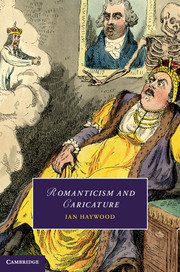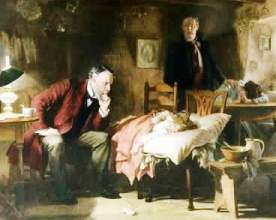Jeremy Davies is Lecturer in English at the University of Leeds; prior to taking up this post in 2011, he studied and taught at Cambridge, Glasgow and Queen Mary. His research focuses principally on the intersections between Romantic poetry, medical thought, and ecology, and he has published essays and articles on Percy and Mary Shelley, Jeremy Bentham, and sustainability and nostalgia. Below, we discuss his first monograph, Bodily Pain in Romantic Literature, recently published by Routledge. The first thirty pages of this fascinating book can be viewed here.
1) How did you come to work on the history of bodily pain, and how did you select the four authors you concentrate on (Jeremy Bentham, the Marquis de Sade, Samuel Taylor Coleridge and Percy Shelley)?
It probably goes back to the first time I opened Prometheus Unbound. I remember being fascinated and a bit revolted by the monologue with which Shelley’s drama begins. Prometheus describes in grisly detail the tortures to which he’s being subjected, and welcomes them as a glorious empire over which he has dominion. I wasn’t sure what to make of that rhetoric of martyrdom, and that puzzlement stayed with me in a productive way: the book ends with a reading of Prometheus Unbound.
When I was struggling to come up with a topic for a PhD thesis, pain occurred to me as a way of thinking about languages of the body in Romanticism. I soon realised that the Romantic period was the last one before the development of surgical anaesthesia, the most dramatic turn in the medical history of pain, and it all seemed to click into place.
Shelley was there from the start, then, but the rest of the quartet all made their way in through different doors. Sade was a characteristically mind-expanding suggestion from my doctoral supervisor. The discussion of Bentham was one of those things that starts off as a passing sentence, which requires another sentence of explanation, and then expands into a chapter. The early years of my thesis were those of the debate sparked by the revelations of the US treatment of prisoners at Abu Ghraib and Guantanamo. Bentham’s writings on torture were being invoked very seriously as supposed proof that ‘Enlightenment values’ were compatible with the strategic deployment of torture. It seemed worthwhile to scrutinise what he’d had to say about inflicting bodily hurt more closely than others were doing. Coleridge came last. I’d known for a long time that I was going to write about him, but I decided not to confront him in my thesis, and I got down to work on him only after coming to Leeds. In a funny way – but perhaps inevitably – the chapter centred on him became in some respects the one holding the book together.
2) Were there other writers you considered but ultimately left out or reduced to cameo roles?
Intriguingly (to me) I’ve just dug out a piece of paper on which, on 23 January 2006, I was scribbling disconnected ideas for possible PhD projects. ‘Pain’ is underlined, and a bunch of ideas follow. Prometheus Unbound is there, but so too are Hyperion and Lamia. Keats isn’t in the book; I suppose I was thinking of Hyperion in his palace, and Lamia’s metamorphosis. Also on that first piece of paper are Thomas Lovell Beddoes and George Cannon, neither of whom got into the book in the end.
Of the writers who play cameo roles, Adam Smith stands out as one who could have taken up a lot more room: his attitude to pain in The Theory of Moral Sentiments is fascinatingly ambivalent. Southey is another, and Harriet Martineau’s Life in the Sick-Room is a compelling text but a bit late for my purposes. The book could have developed into a history of Romantic-period medical ideas about pain. In that case I’d have said more about people like John Brown and Erasmus Darwin, and I might have been tempted back in time to deal with the extraordinary archive of consultation letters that passed between the Edinburgh physician William Cullen and his patients. But I didn’t take that path. I did write about the fierce mid-eighteenth-century debate among medical theorists as to whether freshly dissected organs were capable of feeling pain, and about the key role played by pain in David Hartley’s vibrationist theory of how the mind works. In both those cases, though, I’m most interested in how the issues raised play out later on, in Romantic texts that have a less direct relationship with the history of medicine.
3) What’s so interesting about pain in the Romantic period?
For me, that mostly depends on which individual writer you’re thinking about. There are some general factors, though. Surgical anaesthesia finally emerged in 1846, so the preceding couple of generations are the last ones on the far side of that transformative change. By then, the technology required for anaesthesia had been in place for decades or more (Humphry Davy suggested the possibility of nitrous oxide anaesthesia in 1800, for instance), but nobody had joined the dots. Historians of medicine have puzzled over the question of why that was so. This ‘anaesthesia problem’ makes the Romantic period a loaded site for thinking about attitudes to pain.
Then there’s Foucault’s account of the development of clinical medicine after the French Revolution. He suggests that an epistemic shift is captured by a change in doctors’ characteristic opening question to their patients: from asking them ‘What is the matter with you?’ (an invitation to narrative) to asking ‘Where does it hurt?’ (a decoding of internal signs). That too gives Romantic-period pain a particular resonance. Thirdly, you could look to Romantic aesthetics. What’s the relationship between bodily pain and the culture of the sublime, especially given that many of the canonical Romantics were chronic pain sufferers? I dwell on Coleridge and Shelley, but you might also think about Byron’s club foot, Dorothy Wordsworth’s migraines, and much else.
I’m most interested, though, in how bodily pain became intellectually productive for a series of individual writers. As a starkly exceptional and extreme state of life, pain confronted certain thinkers with particular challenges for their idiosyncratic views of the world. I look at how some writers’ characteristic agendas and preoccupations – which might not obviously have anything to do with physical hurt – ran up against problems raised by pain, and at how they struggled creatively with those problems. Hence the kind of questions I concentrate on. Does Bentham believe that sufficiently intense torture is bound to overcome its victim’s ability to resist interrogation, and what does his answer tell us about his psychological theory? How do Sade’s depraved anti-heroes experience pain differently from the victims of their cruelty, and what does that mean for the relationship between Sade’s characters and their sensations? Why did Coleridge suggest that he’d achieved an intellectual breakthrough by ‘metaphysicizing on Pain’, or – much later – argue that pain helps knit together the great chain of being by reinforcing a polarity between the subjective and the objective? What’s with that first act of Prometheus Unbound? And so on.
4) How have modern medical discourses helped you to reconsider earlier modes of representing pain?
In recent decades there’s been a lot of great work investigating the nature and significance of pain. Scholars have reinterpreted pain not as the product of impulses flowing along specific pain pathways in the nervous system, but instead as an embodied experience that’s necessarily constituted partly by ideas, emotions, and cultural entanglements. That’s helped to undermine the clinically disastrous opposition between ‘authentic’ and ‘psychogenic’ pain, and to bring about more thoughtful and efficacious – because more holistic – methods of treatment for the enormous number of people who suffer from chronic pain. Within medical institutions, that humanist project still has much more ground to win.
For all that, I think that on a still more basic level the cultural study of bodily pain has run into a bit of an impasse. I argue in the book that we can divide recent pain studies in the humanities into two broad schools. There’s a currently dominant tradition arising from the medical humanities, concerned with pain experience as acculturated and meaning-laden. There’s also a relatively subordinated one, best represented by Elaine Scarry’s The Body in Pain, that discerns an inescapable negativity or resistance to language within the feeling of pain. The two traditions have been at cross purposes lately. Though Scarry’s work continues to generate much discussion, it’s often read rather selectively by medical humanists, and without attention to some important precursors (Frederik Buytendjk, David Bakan). I argue that Scarry’s analysis still has more to offer than has fully been recognised. Part of the problem, I think, has been some very imprecise use of the word ‘pain’ by historians of culture.
I try to develop a new account of pain that draws on both recent traditions, and to argue that physical pain is indeed intrinsically mediated by culture, and yet not identifiable with any positive meaning that it carries. I think that the most economical and most serviceable way to characterise bodily pain is as a demand to pay attention to the otherwise diffuse, background sense of sensing the world that arises simply from the fact of embodied existence. Pain is a more or less intense compulsion to notice what Daniel Heller-Roazen calls the ‘inner touch’: the sense of one’s own body that normally hovers on the edge of perception. Characterising physical hurt in this way – as an experience that summons up the feeling of having feelings, in a nutshell – makes it a distinctively reflexive and ironic phenomenon. It neither belongs to language nor is merely opposed to it. That ironic dividedness, I argue, is at the root of its importance for the Romantic-period writers I discuss.
5) What’s next for you?
I’m currently working on a short book called The Birth of the Anthropocene. It begins from the fact that talking about the present environmental crisis often involves references to extremely long-ago times: ‘CO2 levels are at their highest for at least three million years,’ or whatever. That doesn’t really happen in other kinds of political discussion. It seems that ecological politics needs to be able to tell a story about the deep past in order to explain its concerns and its aims – but it’s not very good at telling stories like that at the moment. I think that we might find such a story, a kind of origin myth for green politics, in the idea of the Anthropocene epoch. Over the last decade, many Earth scientists have concluded that the Earth is entering a new geological epoch, one in which human activities are a principal influence on the planet’s geology. That is, after nearly 12,000 years of the Holocene epoch, we’re witnessing the birth of the Anthropocene.
All this might sound a bit remote from Romantic literature. But geology itself emerged as a science in the Romantic era, and the most widely accepted start date for the Anthropocene is precisely our period: the ‘base’ of the Anthropocene is most often associated with industrialisation in late eighteenth-century Britain.
I think the Anthropocene gives us a vantage-point from which to think our way back into deep time, geological time. Recognising industrial civilization as a geologic force allows us to see it in a fresh light, as the source of a new epoch within a series of epochs that stretches back many millions of years. If the idea of the Anthropocene helps us to narrate the long historical context of the present crisis, it might serve – I hope – to nourish and revivify the ecological movement. As the poet Don McKay puts it, the Anthropocene can enable us to recognise human beings as ‘members of deep time, along with trilobites and Ediacaran organisms … one expression of the ever-evolving planet.’





